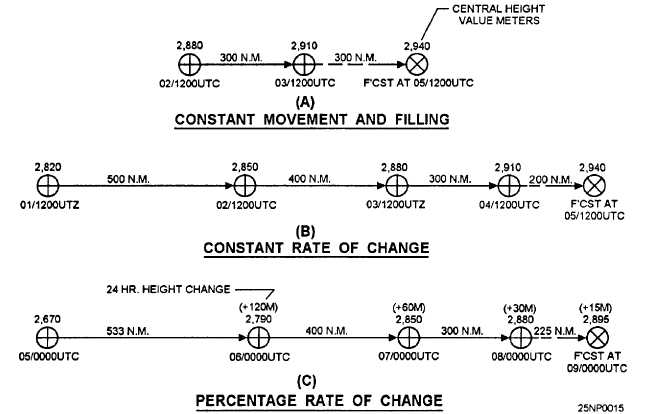example, intensification is caused by high-level cold
advection and/or mass convergence.
l Under low zonal index situations, a blocking
high will normally exist at a northern latitude and will
have a pronounced effect on the systems in that area; in
general it will slow the movement
. Under high zonal index situations, there is a
strong west to east component to the winds, and systems
will move rapidly.
Movement of Closed Lows
The semipermanent Icelandic and Aleutian lows
undergo little movement. These semipermanent lows
will decrease or increase in area of coverage;
occasionally split, or elongate east-west during periods
of high zonal index. North-south displacements are due
primarily to seasonal effects. The movement of these
semipermanent lows is derived primarily from
extrapolation.
EXTRAPOLATION.— Extrapolation can be used
at times to forecast both the movement and the intensity
of upper closed lows. This method should be used in
conjunction with other methods to arrive at the predicted
position and intensity. Figure 2-2 shows some examples
of simple extrapolation of both movement and intensity.
Remember, there are many variations to these patterns,
and each case must be treated individually.
Figure 2-2, view (A), illustrates a forecast in which
a low is assumed to be moving at a constant rate and
filling. Since the low has moved 300 nautical miles in
the past 24 hours, it maybe assumed that it will move
300 nautical miles in the next 24-hour period. Similarly,
since the central height value has increased by 30 meters
in the past 24 hours, you would forecast the same 30
meter increase for the next 24 hours. While this
procedure is very simple, it is seldom sufficiently
accurate. It is often refined by consulting a sequence of
upper air data to determine a rate of change.
This principle is illustrated in figure 2-2, view (B).
By consulting the previous charts, we find the low is
filling at a rate of 30 meters per 24 hours; therefore, this
constant rate is predicted to continue for the next 24
hours. However, the rate of movement is decreasing at
a constant rate of change of 100 nautical miles in 24
hours. Hence, this constant rate of change of movement
is then assumed to continue for the next 24 hours, so the
low is now predicted to move just 200 nautical miles in
the next 24 hours.
Figure 2-2.-Simple extrapolation of the movement and Intensity of a closed low on the 700-mb chart. (A) Constant movement and
filling (B) constant rate of change, (C) percentage rate of change.
2-6

